The calendar of garden visiting is on pause now, and with the skiing season fast approaching one of the gardens I look back at with fondness, is the extraordinary garden at Brundall, once known as ‘The Switzerland of Norfolk’.
The garden was created in 1880 by a Dr Beverley who, along with planting an arboretum, dug out a cascade of ponds as seen in the centre of the postcard below. An entrepreneur named Frederick Holmes-Cooper then purchased the grounds in 1917, built a new house for his family which he called ‘Redclyffe’ and set about making ‘Brundall Gardens’ a visitor attraction with a fine hotel and restaurant.

Postcard 1920
In 1922 it was reported that 60,000 people flocked to see the gardens. Visitors travelled by bicycle, foot, rail and river disembarking at the jetty just by the restaurant.

Postcard advertising day trip to Brundall Gardens
Of course I arrived by car, and it was a cold day back in April. The garden, much reduced in size now is owned by Janet Muter. In the mid 1980s she and her husband bought a newly-built house on the site, just above the cascade and set about restoring the garden. It had suffered much neglect since its closure in the 1930s and subsequent requisition during the war when the property was used as an enemy aircraft plotting station.
I was very touched when Janet presented me with the book, Rescue of a Garden that she has recently written about the fascinating history of her garden.
So I cannot resist starting our tour with a picture of the house taken from the book showing the building in 1986, which she describes amusingly as ”A house undressed”:

Rescue of a garden by Jane Muter
No longer so naked, it is clothed in mahonia and clematis armandii,

and an attractive little border softens the hard landscape by the front door.

From the house we cross to the other side of the roadway which is in fact the drive to the neighbouring house. I have to confess I am a little confused; a rustic hut but where is the lake?
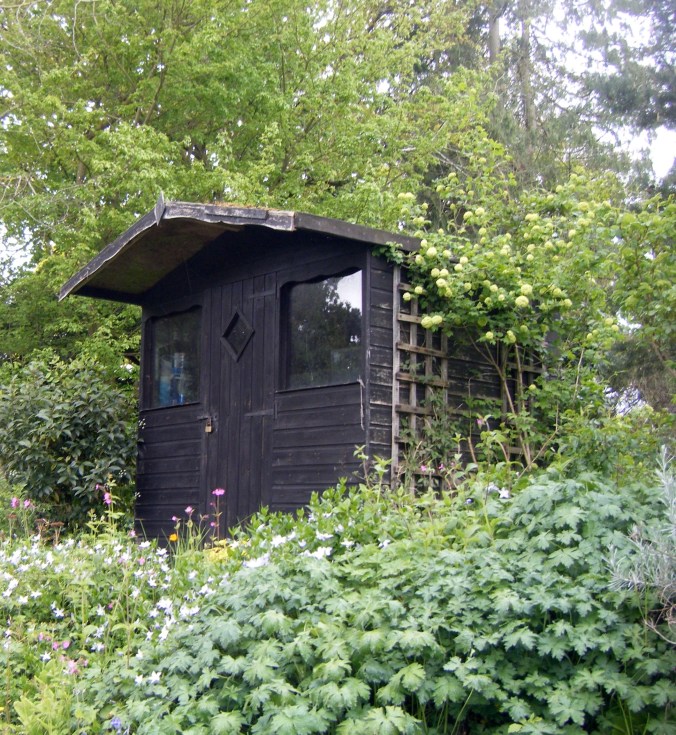
Crossing back over towards the house I admire the mixed planting in the flower bed, and continue to wonder at the apparent lack of water.

Then, walking through the trees towards the south side of the house, I realise that this has just been the warm up. The curtain raises and as I look down, the spectacle unfolds; a series of three delightful ponds descending to a lower lake.

I am standing upon the patio where a collection of colourful acers grow in pots. You can see that the grassy slope falls away very steeply.

We gently follow the path down on the right-hand side admiring the mixture of mature trees and shrubs, some in flower, that have been planted over the years.

The large-handled pot points the way and its shape is complimented by the planting around it. Perhaps a gentle reminder that this was a site once inhabited by the Romans.

The first pond is the smallest. There are no straight lines in this garden; pool, plants and pots smoothly flow in a curve. On occasions, a fountain plays in the centre.

The path leads away from the water’s edge down through swathes of ground cover; vinca, pulmonarias, lamium and ivy dotted with white honesty.
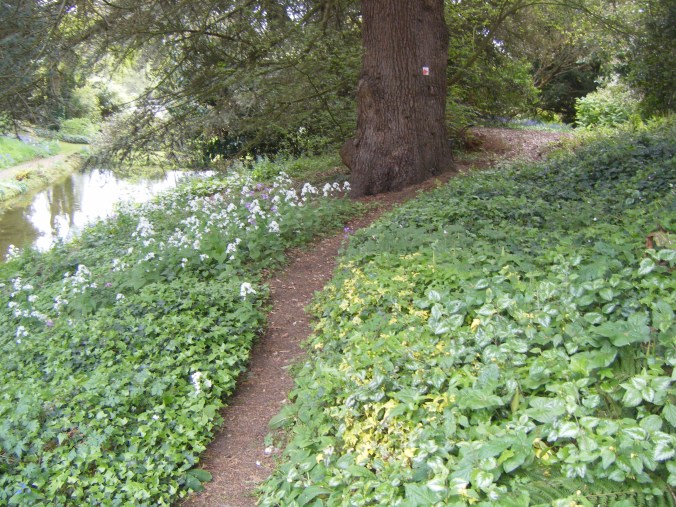
Bluebell flowers are just emerging and I catch glimpses of water through the branches,

and finally at the furthest point we venture out through the trees to arrive at the lily lake at the lowest level.

Large and untamed, the lake was almost inaccessible in 1985.
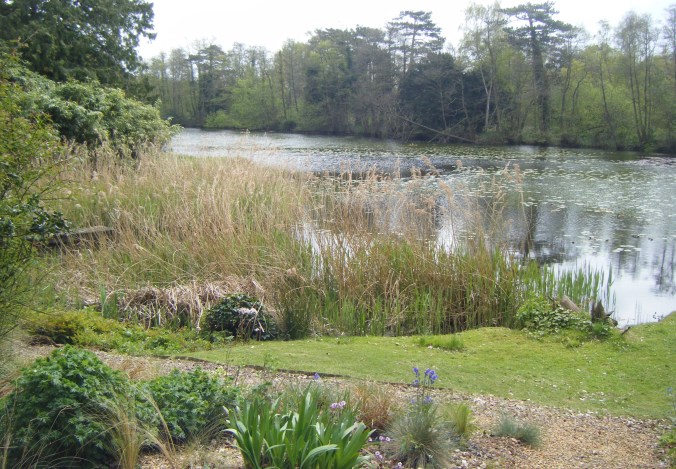
The Muters cleared fallen trees, excess reeds and rushes. Janet has always been mindful of the wildlife, the enjoyment of which is an important part of this garden. A beach was created and the gravel path seems to ebb and flow in harmony with the water’s edge.
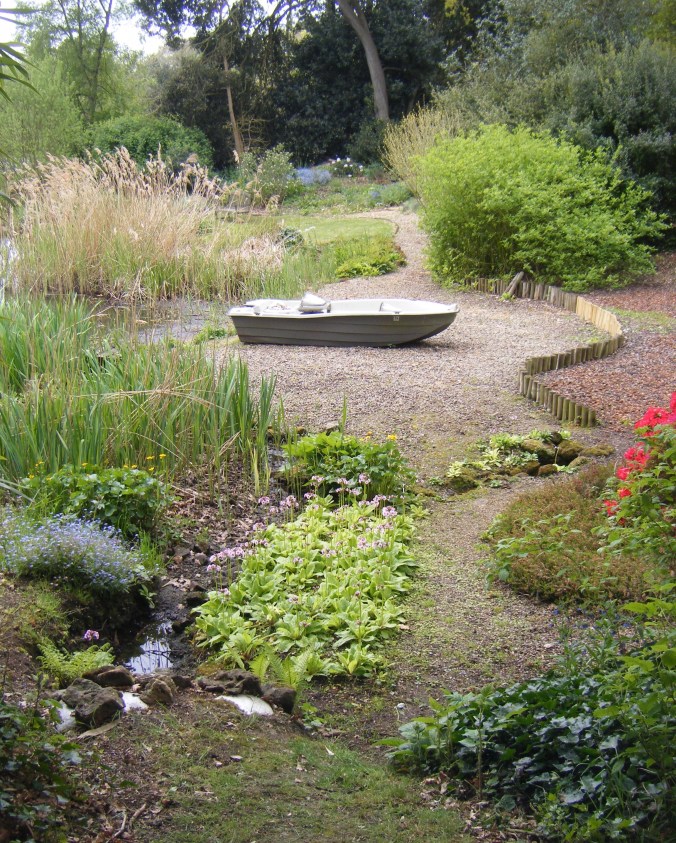
There are some lovely gems planted on this side; the exquisite aronia melonocarpa

and pinky darmera peltata, its large leaves yet to grow.

Popular primula japonica is very content here.

Water lilies spread out in a Monet manner across the lake from the far side, where the sound of a railway can be heard as a train rattles by.

After a while we ascend the side of the lower pond where sweet woodruff grows amongst the fresh green unfurling fronds of the ferns.

At the top of the lower pond we cross over and look back. It is deep and requires dredging every year.

The middle pond is in fact in the care of the neighbour. Annually it is drained to remove the leaves. These water gardens do not just flow timelessly, they need maintenance. There has not been much rainfall in recent months and so the water level is low.
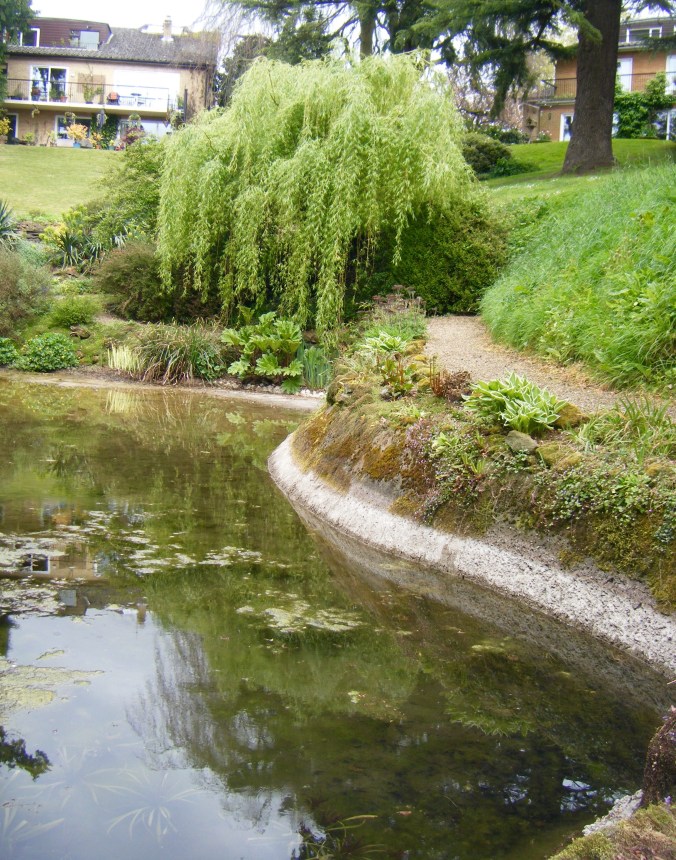
The top pond has a variety of plants emerging around its edge and it is the selection of euphorbias that catches my eye today,

with the ajuga edging the carrstone wall. The stone would have originally been brought over from the western side of the Norfolk.

An old tree trunk supporting a climbing rose combines with an ancient pot to provide a touch of antiquity.

We are grateful to have steps to climb this last part but I worry that I have kept Janet outside for too long. A hardy type as she might be, she is an octogenarian and it is a chilly day.
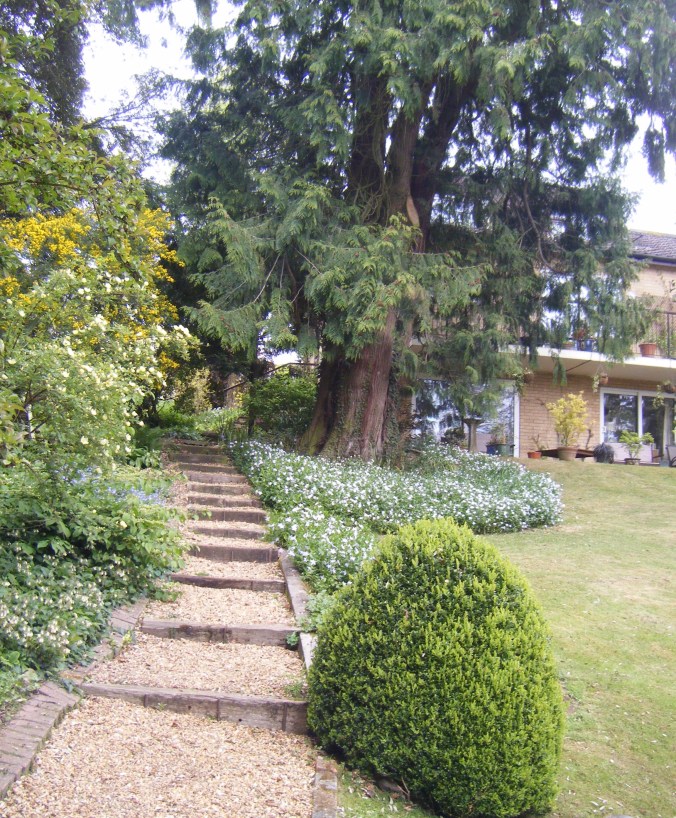
We pause on the top step to take in one last look over the haze of light blue periwinkle. I am in awe as to how someone can garden on such steep terrain.

Watery and wonderful, this can have been no easy garden to restore and maintain. It is hard to believe that for half a century it was hidden away by undergrowth. With careful restoration and a lot of hard graft, the Muters brought it back to life and while enhancing the beauty with their love and knowledge of plants, they have encouraged not only the wildlife to return but also the visitors. I quote from Janet’s book:
‘And in 25 years of opening my garden I have never known anyone leave litter or steal so much as a cutting, well not when I was looking anyway. Whilst rescuing my garden it has helped to raise thousands of pounds for many charities, but mainly for the National Garden Scheme.’
Lakeside House opened for two days this year over the May Bank holiday and raised nearly £3,000 for the NGS.
We are of course very grateful to Janet who will be opening next year by arrangement only. In the meantime you can enjoy this wintery scene and do read the book; it is an interesting story.

——-87——-
What a delight and how apt to finish this tour with a suitably wintery scene. Sadly nearly 90 gardens visited. Well done.
LikeLike
What a wonderful garden. I too can not imagine gardening on such a slope. I do enjoy seeing before and after pictures. Not that you can’t see how much work goes into a garden but the before photos really bring it home. It must have been fascinating to listen to Janet reminisce about the garden.
I do hope there are more gardens to come.
LikeLike
Fascinating-what a steep challenge !
I love the ponds ..
LikeLike
Fascinating history of the site Julia.
LikeLike
A beautiful garden, how hard you have worked to restore it to its former glory. Please could you let me know the opening dates.
LikeLike
It is open by appointment
LikeLike